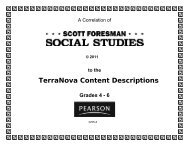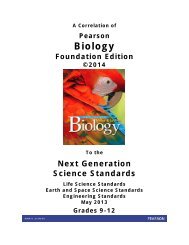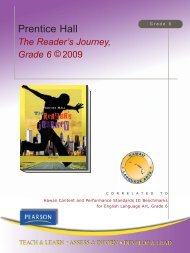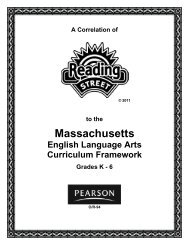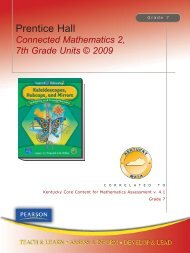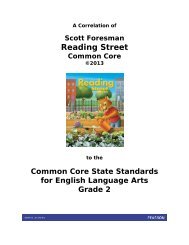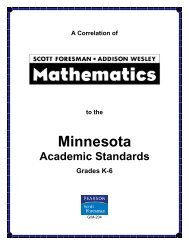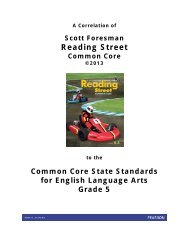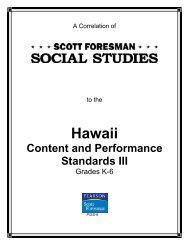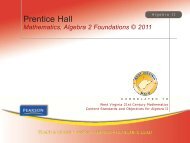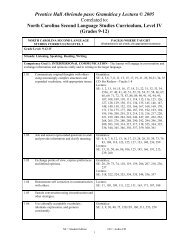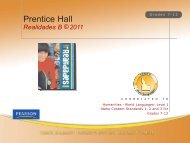Miller & Levine Biology - Pearson
Miller & Levine Biology - Pearson
Miller & Levine Biology - Pearson
Create successful ePaper yourself
Turn your PDF publications into a flip-book with our unique Google optimized e-Paper software.
HS-ETS1 Engineering DesignA Correlation of<strong>Miller</strong> & <strong>Levine</strong> <strong>Biology</strong>, ©2014to the Next Generation Science Standards, May 2013Grades 9-12HS-ETS1 Engineering DesignStudents who demonstrate understanding can:HS-ETS1-1. Analyze a major global challenge to specify qualitative and quantitative criteria and constraints for solutionsthat account for societal needs and wants.MILLER & LEVINE BIOLOGY: In Lesson 1.2 (p. 11), students learn that technology, science, and society are closely linked. Lesson 1.2(pp. 14–15) describes the relationship between science and society. In Lesson 15.4 (pp. 436–439), students explore the ethics and impacts ofbiotechnology.Students specify criteria and constraints for solutions that account for societal needs and wants: In the Unit 8 Project, Body Mechanics(pp. 859a–859b), students evaluate how medical technologies can account for the needs of people living with disabilities or chronicdiseases. Students analyze how cross-pollination affects the genetics of corn populations (Chapter 17 STEM activity, Pollination orContamination). Students analyze the factors involved with replacing a heart (Chapter 33 STEM activity, The Artificial Heart of the Matter).HS-ETS1-2. Design a solution to a complex real-world problem by breaking it down into smaller, more manageable problemsthat can be solved through engineering.MILLER & LEVINE BIOLOGY: In Appendix C, Technology & Design (pp. A-16 and A-17), students learn the general process for designing asolution to a problem.Students design a solution to a complex real-world problem: In the Unit 6 Project, A Living Roof (pp. 571a–571b), students design agreen roof. Students redesign product packaging to reduce solid waste (Chapter 6 STEM activity, Redesign to Reduce Waste). Studentsdesign a mosquito net to help combat malaria outbreaks (Chapter 21 STEM activity, Malaria and Fungi). Students design technology to helpprotect workers from blood-borne pathogens (Chapter 35 STEM activity, Reducing the Spread of Bloodborne Pathogens).HS-ETS1-3. Evaluate a solution to a complex real-world problem based on prioritized criteria and trade-offs that account fora range of constraints, including cost, safety, reliability, and aesthetics, as well as possible social, cultural, andenvironmental impacts.MILLER & LEVINE BIOLOGY: In Appendix C, Technology & Design (pp. A-16 and A-17), students learn to evaluate constraints and maketrade-offs.Students evaluate a solution to a complex real-world problem: In the Unit 1 Project, Harnessing the Fear of Water (pp. 1a–1b), studentsdetermine the criteria for a technological solution to a specific problem. In the Unit 4 Project, Food Fight! (pp. 305a–305b), studentsevaluate the use of GM foods as a way to increase crop yields. In the Unit 8 Project, Body Mechanics (pp. 859a–859b), students identifythe criteria and constraints for a prosthetic limb.The performance expectations above were developed using the following elements from the NRC document A Framework for K-12 Science Education:Science and Engineering Practices Disciplinary Core IdeasConnections to Engineering, Technology,Asking Questions and Defining ProblemsETS1.A: Defining and Delimiting Engineeringand Applications of ScienceAsking questions and defining problems in 9–12 builds on ProblemsInfluence of Science, Engineering, and TechnologyK–8 experiences and progresses to formulating, refining, •Criteria and constraints also include satisfying any on Society and the Natural Worldand evaluating empirically testable questions and design requirements set by society, such as taking issues of risk •New technologies can have deep impacts on societyproblems using models and simulations.mitigation into account, and they should be quantified to and the environment, including some that were not•Analyze complex real-world problems by specifying the extent possible and stated in such a way that one can anticipated. Analysis of costs and benefits is a criticalcriteria and constraints for successful solutions.tell if a given design meets them. (HS-ETS1-1)aspect of decisions about technology. (HS-ETS1-1) (HS-(HS-ETS1-1)ETS1-3)SE: Unit 8 Project (pp. 859a–859b)<strong>Biology</strong>.com: Chapter 17 STEM activity;Chapter 33 STEM activitySE/TE: Science and Society (pp. 14–15);Ethics and Impacts of Biotechnology (pp.436–439)•Humanity faces major global challenges today, such asthe need for supplies of clean water and food or forenergy sources that minimize pollution, which can beaddressed through engineering. These global challengesalso may have manifestations in local communities. (HS-ETS1-1)SE/TE: Using Resources Wisely (pp. 158–165)SE: Building Scientific Literacy, STEM (p.123)<strong>Biology</strong>.com: Chapter 14 STEM activity,Human Genomes and Medicine; Chapter 15STEM activity, Recombinant DNA inGenetically Modified Organisms; Chapter 31STEM activity, Technology and PhysicalDisabilitiesSE = Student Edition; TE = Teacher’s Edition; LMA = Lab Manual A 24



